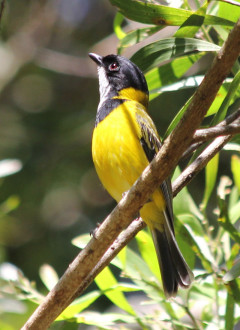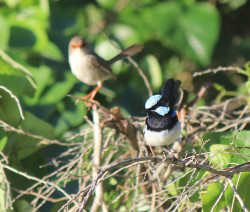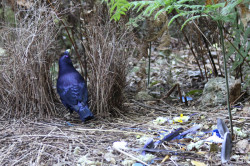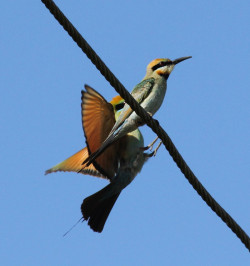A Focus on Gold Coast Birdwatching
Rochelle Steven
 A recently released brochure titled “Bird Places of the Gold Coast” has been met with enthusiasm by numerous stakeholders around South East Queensland. The glossy colourful brochure is the product of a significant amount of effort invested by the collaborators behind it: SEQ Catchments, Birds Queensland, BirdLife Southern Queensland (including the Gold Coast branch), Friends of Federation Walk, City of Gold Coast and Currumbin Wildlife Sanctuary (via National Trust).
A recently released brochure titled “Bird Places of the Gold Coast” has been met with enthusiasm by numerous stakeholders around South East Queensland. The glossy colourful brochure is the product of a significant amount of effort invested by the collaborators behind it: SEQ Catchments, Birds Queensland, BirdLife Southern Queensland (including the Gold Coast branch), Friends of Federation Walk, City of Gold Coast and Currumbin Wildlife Sanctuary (via National Trust).
The aim of the Bird Places of the Gold Coast brochure is to get locals involved in birdwatching around their city of residence, but importantly to act as a tool for visitors to the Gold Coast to see the many beautiful birds living in the city’s parks and reserves. With a subtropical climate and close proximity to World Heritage listed rainforests, the Gold Coast offers premium birdwatching opportunities that to date have been under-utilised and possible under appreciated by many locals. The 46 sites selected for the brochure include a diversity of habitats, including; freshwater wetlands, coastal estuaries, rainforest, eucalyptus forest and even a wastewater treatment plant! These many types of habitats result in a multitude of bird species to see on the Gold Coast. Birds such as, whistling kites, superb fairy-wrens, pheasant coucals, rainbow bee-eaters and many more! The Gold Coasts is so rich in bird species, locals and visitors’ species lists will be limited only by their time spent watching birds, not the number of species present.
 The opportunities for local business to benefit from birdwatching tourism are significant. Research has demonstrated that local economies benefit from birdwatching at the very least through the accommodation they stay in and the food and beverage costs of travelling, as with any other tourism activity. Additionally, they may pay for the assistance of guides to take them to key sites for birdwatching and find key species birdwatchers look for. In the case of the Gold Coast and this new brochure, there are many sites within the Gold Coast city limits that are included in the list of sites outlined. However, within the wider area there are other birdwatching sites that are also renowned for having very good birdwatching characteristics (e.g. Lamington National Park) and these are areas that is can be especially useful to engage the services of a guide.
The opportunities for local business to benefit from birdwatching tourism are significant. Research has demonstrated that local economies benefit from birdwatching at the very least through the accommodation they stay in and the food and beverage costs of travelling, as with any other tourism activity. Additionally, they may pay for the assistance of guides to take them to key sites for birdwatching and find key species birdwatchers look for. In the case of the Gold Coast and this new brochure, there are many sites within the Gold Coast city limits that are included in the list of sites outlined. However, within the wider area there are other birdwatching sites that are also renowned for having very good birdwatching characteristics (e.g. Lamington National Park) and these are areas that is can be especially useful to engage the services of a guide.
 Birdwatching tourism can be a very effective type of ecotourism. In general, the criteria for a tourism activity to qualify as ‘ecotourism’ are; minimal negative impacts on the social and natural environment, maximum benefit for local communities as well as positive conservation, education and economic effects. With that in mind, birdwatching tourism can and should have minimal negative impacts on birds and their habitats. By visiting locally owned businesses for meals and beverages (including day trippers) and engaging the services of a local guide, birdwatchers can deliver the benefits to local communities and local economies.
Birdwatching tourism can be a very effective type of ecotourism. In general, the criteria for a tourism activity to qualify as ‘ecotourism’ are; minimal negative impacts on the social and natural environment, maximum benefit for local communities as well as positive conservation, education and economic effects. With that in mind, birdwatching tourism can and should have minimal negative impacts on birds and their habitats. By visiting locally owned businesses for meals and beverages (including day trippers) and engaging the services of a local guide, birdwatchers can deliver the benefits to local communities and local economies.
 Lastly, but definitely not least, birdwatchers have endless opportunities to learn more about conservation of birds and their habitats. In the case of the Bird Places of the Gold Coast brochure, several sites within the brochure are distinguished from the others due to their status as BirdLife Important Bird and Biodiversity Areas. These are sites that may or may not be formally protected but are recognised as being key sites for conservation of birds and their habitats. Including this information and encouraging birdwatchers to learn more about bird conservation may result in them choosing to join organisations like BirdLife Australia or Birds Queensland (or both!), to give their support of the important work that these groups undertake.
Lastly, but definitely not least, birdwatchers have endless opportunities to learn more about conservation of birds and their habitats. In the case of the Bird Places of the Gold Coast brochure, several sites within the brochure are distinguished from the others due to their status as BirdLife Important Bird and Biodiversity Areas. These are sites that may or may not be formally protected but are recognised as being key sites for conservation of birds and their habitats. Including this information and encouraging birdwatchers to learn more about bird conservation may result in them choosing to join organisations like BirdLife Australia or Birds Queensland (or both!), to give their support of the important work that these groups undertake.
The new brochure provides visitors interested in birds with an easy to use guide to places where birds are in abundance, but will also hopefully inspire locals to observe and value their local birds and advocate for their protection.
For more information about birdwatching and its potential links to local economies and conservation of birds, please contact Rochelle Steven – rochelle.steven@griffithuni.edu.au
Rochelle Steven
BSc. (Hons) PhD Candidate – Griffith University
Thesis title: The relationship between birders, avitourism and avian conservation
Committee Member – Friends of Federation Walk and BirdLife Southern Queensland

When Darryl Jones and I did a survey of needs and attitudes of birdwatching tourists in Australia for the Sustainable Tourism CRC, the two most common answers to an open question of what would improve your birdwatching experience in Australia were preservation of habitat to ensure more birding in the future, and more information available on birds of local areas, so it’s great to see this initiative.